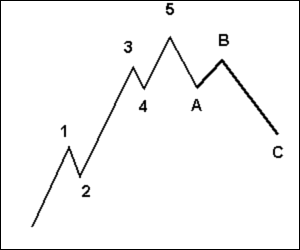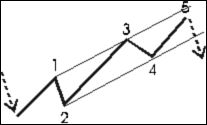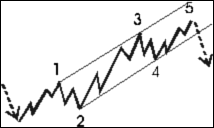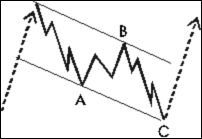Ralph Nelson Elliott developed the Elliott Wave Theory in the late 1920s by discovering that stock markets, thought to behave in a somewhat chaotic manner, in fact, did not. They traded in repetitive cycles, which he discovered were the emotions of investors as a cause of outside influences, or predominant psychology of the masses at the time. Elliott stated that the upward and downward swings of the mass psychology always showed up in the same repetitive patterns, which were then divided into patterns he termed "waves".
The theory is somewhat based upon the Dow Theory inasmuch as the price movements move in waves. It was understood by the technicians at the time that because of the fractal nature of the markets, Elliott was able to break down and analyze the markets in much greater detail.
Elliott was able to spot unique characteristics of wave patterns and make detailed market predictions based on the patterns he identified. Fractals are mathematical structures, which on an ever-smaller scale infinitely repeat themselves. The patterns that Elliott discovered are built in the same way. An impulsive wave, which goes with the main trend, always shows five waves in its pattern. On a smaller scale, within each of the impulsive waves of the before-mentioned impulse, five waves can again be found. In this smaller pattern, the same pattern repeats itself ad infinitum. These ever-smaller patterns are labeled as different wave degrees in the Elliott Wave Principle. Only much later were fractals recognized by scientists.
In the financial markets we know that "every action creates an equal and opposite reaction" as a price movement up or down must be followed by a contrary movement. Price action is divided into trends and corrections or sideways movements. Trends show the main direction of prices while corrections move against the trend. Elliott labeled these "impulsive waves" and "corrective waves".
The interpretation of the Elliott Wave Theory is as follows:
- Every action is followed by a reaction.
- There are five waves in the direction of the main trend followed by three corrective waves (a "5-3" move).
- A 5-3 move completes a cycle.
- This 5-3 move then becomes two subdivisions of the next higher 5-3 wave.
- The underlying 5-3 pattern remains constant, though the time span of each may vary.
 |
You can see that the three waves in the direction of the trend are impulses, so these waves also have five waves. The waves against the trend are corrections and are composed of three waves.
 |
In the 70s, this wave principle gained popularity through the work of Frost and Prechter. They published a legendary book on the Elliott Wave, entitled "The Elliott Wave Principle – The Key to Stock Market Profits". In this book, the authors predicted the bull market of the 1970s, and Robert Prechter called the crash of 1987.
 |
The corrective wave formation normally has three, in some cases five or more, distinct price movements, two in the direction of the main correction (A and C) and one against it (B). Waves 2 and 4 in the above picture are corrections. These waves have the following structure:
 |
Note that the waves A and C go in the direction of the shorter-term trend, and therefore are impulsive and composed of five waves, which is shown in the picture above.
An impulse-wave formation followed by a corrective wave, form an Elliott wave degree, consisting of trends and countertrends. Although the patterns pictured above are bullish, the same applies for bear markets, where the main trend is down.
The Elliott Wave Theory has assigned a series of categories to the waves in order of the largest to the smallest. They are:
- Grand Supercycle
- Supercycle
- Cycle
- Primary
- Intermediate
- Minor
- Minute
- Minuette
- Sub-Minuette




0 Comments:
Post a Comment